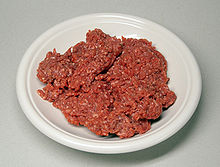- Beef mince
-
Beef mince, ground beef or hamburger meat (in North America), or minced meat (elsewhere) is a minced meat food, made of beef finely chopped by a mincer. It is used in many recipes including hamburgers and cottage pie. In some parts of the world a mincer is sometimes called a meat grinder, although the device works by a process of fine chopping (mincing) and not grinding.
Contents
Contents
In many countries, food laws define specific categories of beef mince and what they can contain. For example, in the United States, beef fat may be added to hamburger, but not to ground beef if the meat is ground and packaged at a USDA-inspected plant.[1] A maximum of 30% fat by weight is allowed in either hamburger or ground beef. Both hamburger and ground beef can have seasonings, but no water, phosphates, extenders, or binders added. Ground beef is often marketed in a range of different fat contents, to match the preferences of different customers.
Beef mince is usually made from leaner, tougher and less desirable beef created when the sides of beef are carved into steaks and roasts.[2] About 17-18% of US ground beef comes from dairy cows.[3][4]
In a study in the USA in 2008, eight different brands of fast food hamburgers were evaluated for water content by weight and recognizable tissue types using morphological techniques that are commonly used in the evaluation of tissue's histological condition. The study found that the content of the hamburgers included:
- Water content 37.7% to 62.4% (mean, 49%)
- Meat content 2.1% to 14.8% (median, 12.1%)
- Skeletal tissue
- Connective tissue
- Blood vessels
- Peripheral nerve tissue
- Plant material
- Adipose tissue
- Bone and Cartilage ("Bone and cartilage, observed in some brands, were not expected; their presence may be related to the use of mechanical separation in the processing of the meat from the animal. Small amounts of bone and cartilage may have been detached during the separation process")[5]
Recent meat processing methods employed companies such as Beef Products Inc., have led to the inclusion of "pinkish slime" (a trimmings meat product that has been separated using a centrifuge and treated with ammonia to remove salmonella and other pathogens) in a wide variety of ground beef products in the USA. This product has been included in US meat products since 2001.[6]
Cuts of beef
Although any cut of beef may be used, chuck steak is one of the most popular choices (because of its richness of flavor and balance of meat and fat). Round steak is also frequently used.
Ground beef is usually subdivided based on the cut and fat percentage:[7]
- Chuck: 78-84% lean
- Round: 85-89% lean
- Sirloin: 90-95% lean
Culinary use
Ground beef is popular as a relatively cheap and quick-cooking form of beef. Some of its most well known uses are in hamburgers, sausages or cottage pie in Britain. It is an important ingredient in meatloaf, sloppy joes, taco, and Midwestern cuisine. Italians use it to make meat sauces, for example, lasagna and spaghetti bolognese. In the Middle East, it is used to make spicy kofta and meatballs. The Scottish dish mince and tatties uses it along with mashed or boiled potatoes. In Lancashire, particularly Oldham, minced meat is a common filling for rag puddings. The Dutch slavink consists of ground beef (half beef, half pork) rolled in bacon.
Raw lean ground beef is used to make steak tartare, a French dish. More finely diced and differently seasoned, it is popular as a main course and as a dressing in Belgium, where it is known as filet américain ("American fillet").
Picadillo is a Spanish term for ground beef, and is a common ingredient in several Latin American cuisines. Picadillo with chili pepper and finely diced onion and potato is a common filling for tacos and gorditas in Mexico.
Food safety
Food safety of ground meat issues are due to possible bacterial contamination. Undercooked Jack in the Box hamburgers contaminated with E. coli O157:H7 were responsible for four deaths and the illness of hundreds of people in 1993.[8] Minced beef must be cooked to 72 °C (160 °F) to ensure that all bacterial contamination, whether it be endogenous to the product or contaminated after purchasing by the consumer, is killed. Cooked color does not always indicate the beef has reached the required temperature, as beef can brown before reaching 68 °C (155 °F).[9] Thus, a thermometer should be used to verify the required temperature has been reached. Contrarily, beef exposed to nitric oxides from open flames (wood, charcoal, propane, etc.) during grilling can remain pink after reaching temperature. The color usually is limited to the surface, so can be distinguished from undercooked meat.
References
- ^ A technicality here is that these rules only apply to meat being sold across state lines. Much ground beef in the US is actually produced at a local grocery store, and is not sold across state lines. In these cases the laws of the local state apply; state laws can have the same or different requirements
- ^ Food Safety and Inspection Service. 2002. Focus on Ground Beef. Fact Sheet, July 2002. [1]
- ^ Espinoza,Mauricio. 2005. Choice of Dairy-Cow Bedding Impacts E. coli Survival, Food Safety. Ohio State University Extension, News Archive, 3/18/2005. [2]
- ^ Animal and Plant Health Inspection Service. 1996. Economic Opportunities for Dairy Cow Culling Management Options. Info Sheet, May 1996 [3].
- ^ http://www.tissuepathology.typepad.com/files/prayson_anndiagpath_dec2008.pdf
- ^ http://www.nytimes.com/2009/12/31/us/31meat.html
- ^ BeefRetail.org: http://www.beefretail.org/reseGroundBeefCategoryBreakdown.aspx
- ^ http://www.ou.edu/deptcomm/dodjcc/groups/02C2/Jack%20in%20the%20Box.htm Case Study: Jack in the Box E. coli crisis
- ^ Temperature rules http://www.fns.usda.gov/tn/Resources/TempRulesPoster.pdf
External links
- Ground Beef Safety at About.com
- Ground Beef Nutrition Information from USDA SR 22 database
Categories:
Wikimedia Foundation. 2010.

